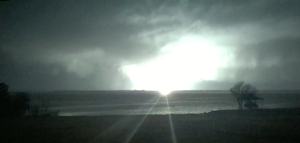Home Tips for Dealing with Texas Storm Damage

A Texas homeowner captures an explosion near Dallas during a Tornado storm.
Recent storms that raged across North Texas hit the area with blizzard conditions and numerous tornadoes. According to the National Weather Service, an EF4 tornado went through Garland and an EF3 tore up much of Rowlett. Copeville was also the victim of severe weather with an EF2 twister hitting town. Smaller tornadoes were also reported in the Blue Ridge, Emory, Eustace and Hubbard areas.
The damage was significant, 11 people died and local officials estimated that 1,450 homes were destroyed or damaged. Vehicles were destroyed, as were trees and power lines. Heavy rains, strong winds and cold temperatures made cleanup efforts difficult.
While recovering their possessions and assessing the damage to their home will be the first step for most homeowners, contacting their insurance company and filing a claim will also be a high priority.
The Insurance Counsel of Texas and USAA have put together a few tips for homeowners whose property was damaged in the storms. Follow these tips to make sure the claims process goes quickly and smoothly:
- Assess the damage to your home as soon as it is safe to enter your neighborhood and home. Carefully examine your home and vehicle. Take photos or video of the damage and contact your insurance company as soon as possible.
- Quickly make temporary repairs to your home to help prevent further damage. Boarding up windows or putting a tarp over your home if the roof has been blown off is just a couple of examples.
- Do not make permanent repairs to the house until a claims adjuster had been able to assess the damage to your home.
- If your home is completely destroyed and uninhabitable, contact your insurance agent as soon as safely possible to make arrangements for reimbursement of your temporary living expenses.
Be sure to give your agent updated contact information if you know where you will be staying.
If possible, post a sign outside your destroyed home with your address so a claims adjuster is aware of where your home used to be, including your current contact information on the sign is a good idea as well.
- Save all receipts for materials related to temporary repairs and relocation or temporary shelter expenses. This will make the claims process go much quicker.
- Write out a detailed list of your damaged items. Include a description, date of purchase and what it would cost to replace or repair your property. If you have receipts or copies of receipts for the damaged property gather them together in anticipation of the adjusters visit.
- Beware of fraudulent contractors who tend to show up in communities that have been struck by severe weather. Check references, contact the Better Business Bureau and if the price seems too good to be true, it probably is.
- One of your first questions you will have for your agent is how long will my claim take. In Texas, insurers have 15 days after receiving your claim to notify you if the claim has been accepted or is being rejected. It is possible that the Texas Department of Insurance will extend the deadline in the event that insurance companies are overwhelmed with claims.
- If you are unhappy with the settlement, most insurance policies have an appraisal process to help settle disputes. Contact your agent or read your policy to determine how the process works with your particular insurer. Once an agreement has been reached, your insurer has five days to mail your check.
For questions or related Texas home insurance coverage information, please contact us at 877-878-3910 today or get Texas homeowners insurance quotes now!
